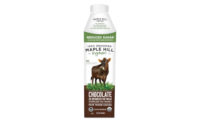Cows fed a 100% organic grass and legume-based diet produce milk with elevated levels of omega-3 and CLA, according to a collaborative research project with the University of Minnesota, Minneapolis; Johns Hopkins University, Baltimore, Md.; Newcastle University, England; Southern Cross University, Australia; and the Aarhus University Hospital, Denmark. Researchers found that the improved fatty acid profile in grass-fed organic milk and dairy products (also known as grassmilk) brings the omega-6/omega-3 ratio to a near 1 to 1, compared to 5.7 to 1 in conventional whole milk.
“With growing consumer demand for organic dairy products, producers may be able to expand their profitability and market share by converting to grass-based pasture and forage-feeding systems,” says Dr. Bradley Heins, associate professor of dairy science at the University of Minnesota’s West Central Research and Outreach Center and co-author of the research project.
Findings from the study, “Enhancing the Fatty Acid Profile of Milk through Forage-Based Rations, with Nutrition Modeling of Dietary Outcomes,” compared the fatty acid profile of milk from cows managed under three systems in the United States:
- “Grassmilk” cows receive an essentially 100% organic grass and legume forage-based diet via pasture and stored feeds like hay and silage.
- “Organic” cows receive, on average, about 80% of their daily dry matter intake (DMI) from forage-based feeds and 20% from grain and concentrates.
- “Conventional” cows are fed rations in which forage-based feeds account for an estimated 53% of daily DMI, with the other 47% coming from grains and concentrates. Conventional management accounts for over 90% of the milk cows on U.S. farms.
Grassmilk provides by far the highest level of omega-3s—0.05 grams per 100 grams of milk (g/100 grams), compared to 0.02 g/100 grams in conventional milk, a 147% increase in omega-3s. Grassmilk also contains 52% less omega-6 than conventional milk and 36% less omega-6 than organic milk. In addition, the research team found that grassmilk has the highest average level of CLA—0.043 g/100 grams of milk, compared to 0.019 grams/100 grams in conventional milk and 0.023 grams/100 grams in organic.
“The near-perfect balance of omega-6 and omega-3 fatty acids in grassmilk dairy products will help consumers looking for simple, lifestyle options reduce the risk of cardiovascular and other metabolic diseases,” says Charles Benbrook, a visiting scholar at the Bloomberg School of Public Health at Johns Hopkins University and co-author of the report.
The team analyzed over 1,160 samples of whole grassmilk taken over three years from on-farm bulk tanks prior to any processing. All samples came from farmer members of CROPP Cooperative, La Farge, Wis., and were tested by an independent laboratory.



